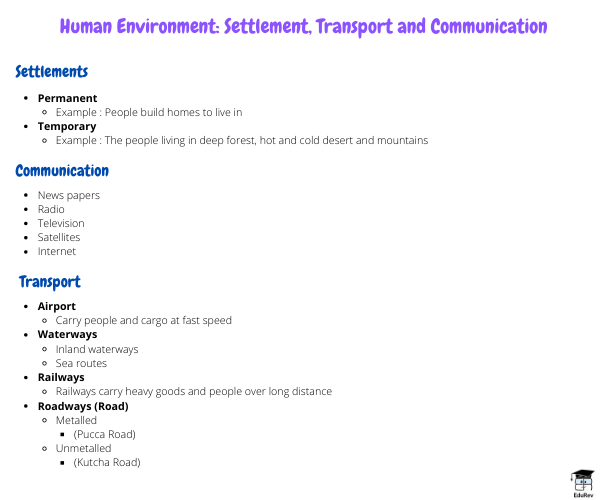Class 7 Exam > Class 7 Notes > Footprints Class 7: Book Solutions, Notes & Worksheets > Mind Map: Human Environment: Settlement, Transport and Communication
Mind Map: Human Environment: Settlement, Transport and Communication | Footprints Class 7: Book Solutions, Notes & Worksheets PDF Download

The document Mind Map: Human Environment: Settlement, Transport and Communication | Footprints Class 7: Book Solutions, Notes & Worksheets is a part of the Class 7 Course Footprints Class 7: Book Solutions, Notes & Worksheets.
All you need of Class 7 at this link: Class 7
|
32 videos|247 docs|40 tests
|
FAQs on Mind Map: Human Environment: Settlement, Transport and Communication - Footprints Class 7: Book Solutions, Notes & Worksheets
| 1. What are the factors that influence settlement patterns? |  |
Ans. Settlement patterns are influenced by various factors including geographical features, availability of resources, climate, economic opportunities, and historical events. For example, people tend to settle near rivers or coastlines for easy access to water and transportation, while others may choose areas with fertile soil for agriculture.
| 2. How does transportation impact settlement patterns? |  |
Ans. Transportation plays a vital role in shaping settlement patterns. Areas with good transportation infrastructure, such as highways, railways, and ports, are more likely to attract settlements as they offer better connectivity and access to markets. In contrast, remote areas with limited transportation options may have sparse settlements due to difficulties in travel and trade.
| 3. What role do communication networks play in human settlements? |  |
Ans. Communication networks, such as telephone lines, internet connectivity, and mobile networks, are essential for modern human settlements. They facilitate the exchange of information, enable businesses to operate efficiently, and connect people across different locations. Access to reliable communication networks is crucial for economic development and social connectivity.
| 4. How do urban and rural settlements differ in terms of infrastructure? |  |
Ans. Urban settlements are typically characterized by more developed and extensive infrastructure compared to rural settlements. Urban areas have better road networks, public transportation systems, schools, hospitals, and other amenities. In contrast, rural settlements often have limited infrastructure, with fewer facilities and services available to residents due to lower population density and economic constraints.
| 5. What are the impacts of migration on settlement patterns? |  |
Ans. Migration can significantly impact settlement patterns. When people migrate from rural to urban areas, it leads to urbanization, with the growth of cities and towns. This can result in overcrowding, strain on infrastructure, and increased demand for housing and services. On the other hand, migration from urban to rural areas can lead to the revitalization of rural settlements, bringing new economic opportunities and population growth.
Related Searches
















